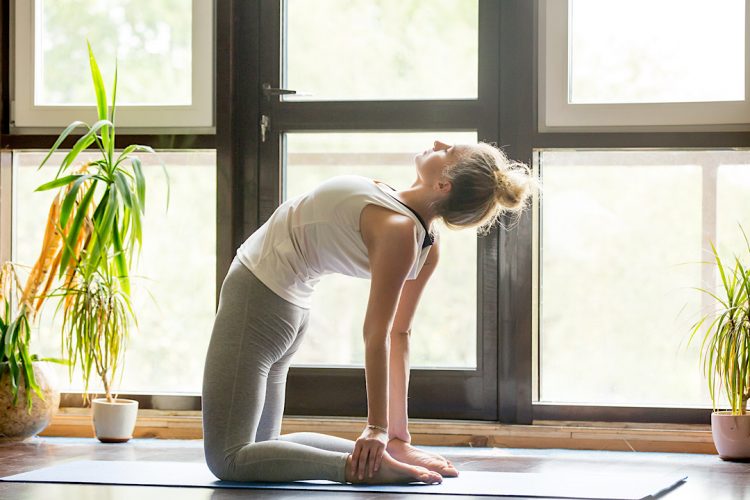There’s no shortage of yoga poses that provide major benefits: downward dog, savasana, and cat-cow pose, to name a few. Another pose to add to your next yoga flow? Ustrasana, also known as camel pose. This heart-opening backbend feels as yummy as it looks, and it’s especially delicious after you’ve spent the day hunched over a desk or computer, says Sabrina Washington, a CorePower Yoga instructor in Sacramento, California, making it a great transition exercise as you get ready to unwind for the evening. Read on to hear more camel pose benefits, as well as step-by-step instructions on how to do it, and precautions to keep in mind.
Ustrasana or camel pose benefits
1. Stretches and strengthens
Besides providing a really great stretch, Washington says camel pose also helps strengthen your abs, thighs, back, hamstring, and glutes.
2. Corrects rounded shoulders
Many of us spend too much time slouched over something (computer screen, cell phone, steering wheel, etc.). “Unfortunately, our shoulders, upper back, spine, and neck suffer the consequences,” Washington says. “Camel pose counteracts this by literally opening up our chest and maneuvering our spine in the opposite direction to correct rounded shoulders, relieve pain that has accumulated in our necks and upper backs, and strengthen our spine.”
Related Stories
3. Helps with back pain
In addition to correcting rounded shoulders, this pose can also help prevent back pain. “Oftentimes, back pain can come from poor posture, which may be the result of a weak core or hunched upper body,” Washington says. “When done properly, camel pose engages the muscles in your back and abdominals, which can help prevent future issues.”
4. May relieve constipation
If you’ve gone a few days without pooping, you may want to add this pose to your yoga flow. “Yoga has been [shown] to help with digestion,” Washington says. “Camel pose, in particular, stretches your abdominals, stomach, and intestines, which are key to healthy digestion and relieving constipation.”
5. Opens up your chest
“Camel pose is a backbend that opens your heart chakra to giving and receiving joy, love, and compassion,” Washington says, adding that it can also make breathing easier because it increases your breathing capacity. With heart-opening poses like this, some people may feel vulnerable or emotional during or after the pose. Washington advises being gentle with yourself and taking it at your own pace if this happens.
6. Cultivates a sense of inner harmony
Overall, most people feel calm, empowered, and strong when doing Ustrasana. “Some people also find this pose very relaxing, which can decrease overall stress and anxiety levels to help create a sense of inner peace,” Washington says.
How to do the Ustrasana or camel pose
The key with the camel pose is not to overdo it with the backbend. “The priorities are to find a backbend that you do not want to run away from and to discover a shape where you can breathe deeply for about 30 seconds,” Washington says.
Start by kneeling at the center of your mat with your knees directly under your hips. Place your hands on your lower back with fingers pointing down toward the floor. As you inhale, lift your chest toward the ceiling, leading with your heart, to create a C-curve with your back. Take a moment here to check in on how this sensation feels. You can hold here for for 30-60 seconds. Or, take this pose deeper by engaging your thighs and glutes (this helps protect your lower back) and bring your hands onto your heels. Ensure your hips remain stacked over your knees and keep your chin pointed towards your chest. Hold the pose for 30–60 seconds.
To come out of the pose, place your hands back on your hips. Engage your abs as you slowly lift your chest back to an upright position. Lastly, with your hands on your thighs, take a few breaths to calm your heart rate and ground yourself if you feel disoriented.
Pro tip: “Always listen to your body, and make sure you take the time to safely exit the pose,” Washington says.
Ustrasana precautions
While camel pose is a great move for most people, Washington advises skipping it if you’re injured, are recovering from surgery, or experienced chronic knee, shoulder, neck, or back pain. “This is an intermediate and more strenuous pose that can agitate preexisting muscle aches or joint issues in these areas,” she warns. “Be sure to speak with your doctor if you have any concerns before practicing yoga.”
Washington also notes that some people experience headaches after doing backbends. To prevent this from happening, she suggests adding a camel pose toward the end of a yoga sequence rather than at the beginning. “This way, our bodies are properly warmed up, stretched, and prepared for the opening,” she says. Or, at least do some cat-cow stretches to activate your abs and back first.
Unintentionally holding your breath while leaning into the pose or holding a backband may also lead to headaches. So, “use your breath as a guide for your movement,” Washington says. “For example, let your inhale create lift in your chest, and use your exhale to discover depth.” Again, the important thing with Ustrasana is not to overextend yourself. “Find a backbend where you can mindfully breathe throughout the duration of the pose.”
Practice your camel pose, along with other chest openers, in this 10-minute stretching video:
Source by www.wellandgood.com










